Points of Interest
There are many significant points of interest in and around the Chapel of Saint Mary of the Cross. Explore each of the features listed to learn something of their development and symbolic meaning. Explore our sculptures, walk our Labyrinth and see our magnificent Chapel. Journey into our College to tour and learn about our sacred spaces.
 It was Bunjil the Great Creator Spirit who made the mountains, the rivers, the rocks and the stones and created all living creatures and taught them how to behave. Bunjil, through the Dreaming stories, taught all of creation to live in harmony.
It was Bunjil the Great Creator Spirit who made the mountains, the rivers, the rocks and the stones and created all living creatures and taught them how to behave. Bunjil, through the Dreaming stories, taught all of creation to live in harmony.
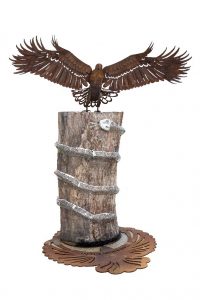 We remember the Indigenous way of being where all is connected – land, spirit, people. To understand this we must understand the First Peoples’ relationship with the Creator Spirit, with the land and indeed with all of creation. Everything is sacred – the animals, plants, hills, mountains, trees, leaves, rocks, stones, river, lakes, oceans, everything. All have as much right to exist as we humans do. If we dishonour their right, we dishonour our own right to be.
We remember the Indigenous way of being where all is connected – land, spirit, people. To understand this we must understand the First Peoples’ relationship with the Creator Spirit, with the land and indeed with all of creation. Everything is sacred – the animals, plants, hills, mountains, trees, leaves, rocks, stones, river, lakes, oceans, everything. All have as much right to exist as we humans do. If we dishonour their right, we dishonour our own right to be.
MacKillop College honours the traditional owners of the land by presenting a portrayal of Bunjil the Eaglehawk, the totem of the traditional peoples on which the college is built. Myndii, the great snake that punished unlawful behaviour and acted under the power of Bunjil is also included. The serpent links us to our Christian creation myths as it winds around a log from the Tenison Woods Tree, a tree under which Julian Tenison Woods and Mary MacKillop are said to have prayed. The log itself sits on the image of a dove representing the breath of the Holy Spirit.
THE ARTIST’S STATEMENT – by Chris Sage
‘Do Not Be Afraid I am With you’.
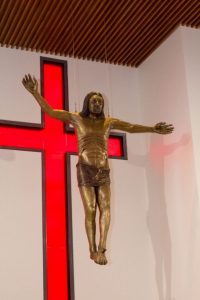
The sculpture depicts Christ as risen, Triumphant over Death. He stands before us transformed. His arms are generous in their pose…welcoming us, protecting us and calling us to place him at the center of our lives.
The wounds are shown as a reminder of Jesus’ great sacrifice for us and are a poignant
reminder to us that suffering is an essential part of our life and growth. The wounds invite us to meditate on this part of the Passion Story and our own stories.
The hands and feet have been slightly elongated for aesthetic purpose but also because these parts of the body enable us to act, to give, to bare witness while walking in Christ’s footsteps.
We do not concentrate on the agony of the crucifixion but on Christ, the man, the Son of God. The expression of the face endeavors to evoke compassion, mercy and above all forgiveness.
The sculpture is not static, it has the appearance of moving forward, a metaphor for our own lives. In the creation of this sculpture, we hope that the central spirit of the work is love in action.
As St Paul wrote:
For we walk by faith, not by sight
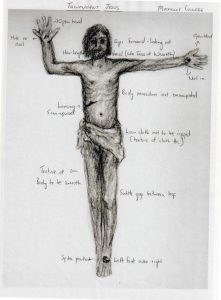
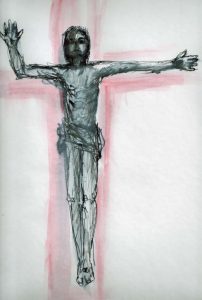
The original annotated concept \ designs by the artist, Chris Sage
 Artist: Sister Therese Quinn RSJ
Artist: Sister Therese Quinn RSJ
Constructed by David Glyn Davies
Two major themes are represented throughout the stain glassed windows of the Chapel of Saint Mary of the Cross.
Firstly, there is God’s covenant represented by the rainbow and explained in Genesis 9:16 where God said, ‘This is the sign of the covenant that I make between me and you and every living creature that is with you, for all future generations: I have set my bow in the clouds, and it shall be a sign of the covenant between me and the earth.’ When we see a rainbow we are reminded of our link with God and with every living creature on the earth.
By using this image we acknowledge our inextricable relationship and connection to God and one another, and all living creatures.
The second theme running through the windows is that of the tree of life. The tree of life is a mystical and spiritual concept that runs throughout many cultures, dating back to ancient times. Different cultures call it by different names and surround it with different mythology, however, they all have similar meanings as the source of life in their respective cultures.
The tree of life symbolises the nurturing aspects of God and of life. In its branches it symbolises reaching out to accept the nourishment of the sun. In its leaves it captures that nourishment and cherishes it through transformation into life giving food.
In its roots it digs deep into the soul of the Earth. It embraces the Earth with its roots and recognises the soil as its mother. In the roots and branches it acknowledges Mother Earth and Father Sun. It is a full recognition of the life that supports it and its spiritual origins.
Window 1: The Kulin People
 The ‘Tree of Life’ is immediately identifiable in this window. The tree represented is a ‘canoe’ tree used by the Wathaurong and Wurundjeri people of the Kulin Nation who are the first peoples to this area. Bunjil, the creator, flies across the sky. The leaves of the tree spill out to acknowledge the land, which we now know as the Werribee Gorge and Werribee River.
The ‘Tree of Life’ is immediately identifiable in this window. The tree represented is a ‘canoe’ tree used by the Wathaurong and Wurundjeri people of the Kulin Nation who are the first peoples to this area. Bunjil, the creator, flies across the sky. The leaves of the tree spill out to acknowledge the land, which we now know as the Werribee Gorge and Werribee River.
Perched in the tree is the ‘leadbeater possum’, once native to Werribee and now critically endangered, despite being on the Victorian emblem. This possum was once vital to the survival of those living in the area. The Aboriginal woman depicted wears the possum skin coat and carries her baby on her back, indicating that this area has been cared for successfully by generation after generation of people.
Window 2: Our Contemporary World
 The second window represents our contemporary world and present generations. Once again the ‘Tree of Life’ is explicit and all life springs from its branches. In the very roots of the tree we find an image of the first prefabricated building, now known as ‘Penola’ in which the college first began. From this seed all that MacKillop has become has grown.
The second window represents our contemporary world and present generations. Once again the ‘Tree of Life’ is explicit and all life springs from its branches. In the very roots of the tree we find an image of the first prefabricated building, now known as ‘Penola’ in which the college first began. From this seed all that MacKillop has become has grown.
As we move up the branches we see an image of Sister Giovanni Farquer, founding Principal of MacKillop College, resplendent in her traditional white. The figures on the left represent the teachers, past and present of MacKillop who, through the gift of their relationships, have nurtured and grown so many students. The images on the right represent the students and their many talents. We see a student playing the violin, someone playing football and another student presenting at a microphone. The group at the top of the window represent our past students who are looking back and reflecting on their journey through MacKillop College.
At the base of the tree is blue water representing the river of life and the Werribee River. This water feeds the seed of one generation to the next and imbues it with its life and energy.
Window 3: Joy and Freedom
 In Matthew’s Gospel (Matthew 6: 25-34) Jesus tells us to consider the freedom of the birds of the air and the flowers of the field and know their joy, rather than be concerned with the worries and concerns of everyday life. Jesus reminds us to trust in God and find joy wherever we are able.
In Matthew’s Gospel (Matthew 6: 25-34) Jesus tells us to consider the freedom of the birds of the air and the flowers of the field and know their joy, rather than be concerned with the worries and concerns of everyday life. Jesus reminds us to trust in God and find joy wherever we are able.
This window reminds us of the above, with a bird soaring through the rainbow representing the freedom and joy found in God’s love. A single flower is also included as a reminder to take note of the small and simple joys of life.
Our College motto, ‘Freedom and Joy Forever’ has been captured in the window but has playfully been reversed by Sister Therese, so that we focus more on the joy of life.
‘Joy is the most infallible sign of the presence of God.’ (Pierre Teilhard de Chardin) As such, we are challenged to find joy even in our deepest sorrows. In John 16: 22 we are told, ‘So you have pain now; but I will see you again, and your hearts will rejoice, and no one will take your joy from you.’
Window 4: Father Woods
 In this window we once again see the tree of life, this time represented as the ‘Father Woods Tree’ from outside Penola in South Australia. It is believed that Father Woods sat beneath this tree to prepare his sermons. The tree is now labelled with a sign indicating this significant site.
In this window we once again see the tree of life, this time represented as the ‘Father Woods Tree’ from outside Penola in South Australia. It is believed that Father Woods sat beneath this tree to prepare his sermons. The tree is now labelled with a sign indicating this significant site.
Father Julian Tenison Woods was acknowledged by Mary MacKillop as the co-founder of the Sisters of Saint Joseph and as such, plays an important part in the development of the Josephite charism. He is represented here holding a book as he was a famous scholar and formally acknowledged scientist, geologist and artist. Some of his drawings of fossils and plants are present in the window.
Above Father Woods is the image of the first school he and Mary MacKillop established in Penola. It was a simple barn converted into a classroom with the assistance of Mary’s brother John. At Father Woods’ side is a contemporary MacKillop student studying science and continuing the journey of learning and discovering new knowledge which was so important to Father Woods. The LE@RN image, from the floor in the Anderledy building, has been included to symbolise the continuing and growing nature of learning. Placing this beside Father Woods links us to our past but also connects us to our yet to be discovered future.
Window 5: John the Baptist
 The setting sun, as seen in our college emblem, greets us in this window. Emanating from the sun is the light of the world which nurtures, sustains and generates energy and warmth. The yellow sun is the source of life, Christ’s light, the Divine consciousness and faithfulness. The sun’s rays focus and concentrate on the energy of Christ’s light. Truth, purity and strength are represented by white. The sun setting in the west firmly links us to our place in the Western suburbs of Melbourne.
The setting sun, as seen in our college emblem, greets us in this window. Emanating from the sun is the light of the world which nurtures, sustains and generates energy and warmth. The yellow sun is the source of life, Christ’s light, the Divine consciousness and faithfulness. The sun’s rays focus and concentrate on the energy of Christ’s light. Truth, purity and strength are represented by white. The sun setting in the west firmly links us to our place in the Western suburbs of Melbourne.
Beneath this are two figures, the first being John the Baptist. John the Baptist was a significant inspiration to Mary MacKillop. John’s role in the gospels was to ‘Make straight the way of the Lord’ (John 1:23) and as such we see John setting out on a path, ready for a long journey carrying his water bag. The second image is that of a contemporary MacKillop student setting out on their own life’s journey and replicating John’s work of bringing about God’s love. The student is represented carrying a backpack and hiking along the river.
Our sense of place is also captured in the bottom of the window with another image of the Werribee River. Surrounding it are the market gardens which are so important in this area.
Window 6: Mary, Mother of Jesus
 John’s Gospel (John 1:14) says, ‘And the Word became flesh and lived among us’ and so in this window we see a representation of Mary, the mother of Jesus. Mary is seen handing Jesus over to Earth as gift to all humanity. Australia is clearly visible on the image of Earth and is prominently placed to anchor the chapel and image in the Southern hemisphere. So too is the representation of the Southern Cross at the very top of the window and inclusion of native fauna at the base.
John’s Gospel (John 1:14) says, ‘And the Word became flesh and lived among us’ and so in this window we see a representation of Mary, the mother of Jesus. Mary is seen handing Jesus over to Earth as gift to all humanity. Australia is clearly visible on the image of Earth and is prominently placed to anchor the chapel and image in the Southern hemisphere. So too is the representation of the Southern Cross at the very top of the window and inclusion of native fauna at the base.
Mary is represented as expressed in the book of Revelations 12, ‘a woman clothed with the sun, with the moon under her feet, and on her head a crown of twelve stars. And she gave birth to a son, a male child, who is to rule all the nations…’
Each of the animals represented in this window are linked to their young in a similar fashion to Mary and Jesus. In effect, they are mirroring the loving and nurturing relationship between Mary and her baby.
Window 7: Sacred Heart of Jesus
 The Sacred Heart of Jesus is a significant aspect of Saint Mary MacKillop’s spirituality and is represented in this window. The cross on which Jesus has been placed has been formed in a curved flowing manner to swing out and capture the joy that was given through the crucifixion. We are reminded that life is given through the cross – not taken.
The Sacred Heart of Jesus is a significant aspect of Saint Mary MacKillop’s spirituality and is represented in this window. The cross on which Jesus has been placed has been formed in a curved flowing manner to swing out and capture the joy that was given through the crucifixion. We are reminded that life is given through the cross – not taken.
The Gospels tell us that after Jesus died on the cross a soldier pierced his side, out of which blood and water flowed. At this point Jesus hands over the Spirit (John 19:30) and the cross becomes the tree of life. The water might also be interpreted as the waters and blood of child birth – necessary so that new life can happen.
Jesus, one with the cosmos as water flows out to nurture and cultivate Earth allowing life, in all its forms, to bring life to the planet. A series of Australian animals are represented including birds, mammals and reptiles.
Window 8: Mary MacKillop
 This window captures an image of Saint Mary MacKillop and a contemporary MacKillop student contemplating a simple flower. They are engaged in the very act which Jesus reminded us to do, that being to ‘consider the lilies of the field’ (Matthew 6:21). Mary MacKillop is sharing her wisdom with the young girl. This is also an acknowledgement of the importance of relationships between the young and old, between students and teachers.
This window captures an image of Saint Mary MacKillop and a contemporary MacKillop student contemplating a simple flower. They are engaged in the very act which Jesus reminded us to do, that being to ‘consider the lilies of the field’ (Matthew 6:21). Mary MacKillop is sharing her wisdom with the young girl. This is also an acknowledgement of the importance of relationships between the young and old, between students and teachers.
Behind Mary and her student is the tree of life which has the ‘joyful’ cross integrated into it. Behind it the blazing Australian sun shines forth. Again a birds soars free to the heavens and in and around the tree are various Australian flora and fauna, including the King Parrot, Pink Heath, Yellow Wattle and some of the other species of birds for which the Werribee area is famous for.
Window 9: Saint Joseph
 At the top of this window we have another glimpse of the rainbow that links us eternally to the love of God. The focus of this window is Saint Joseph, for whom the Sisters of Saint Joseph were named and as such, is an integral part of the charism of Mary MacKillop.
At the top of this window we have another glimpse of the rainbow that links us eternally to the love of God. The focus of this window is Saint Joseph, for whom the Sisters of Saint Joseph were named and as such, is an integral part of the charism of Mary MacKillop.
Once again we see a ‘joyful’ cross, this time integrated with a palm tree. This palm tree is in reference to a piece of scripture from Psalms, ‘The just will flourish like the palm tree’ (Psalms 92:12) as the actions of Saint Joseph indicate he was truly just. Joseph is also represented with a contemporary MacKillop student. In Joseph’s hand we see a scroll containing Jewish Torah, the historic basis of our bible. In the young man’s hands we see a book containing the Second Testament, sometimes known as the New Testament. Again, both figures are in relationship and sharing wisdom.
Beneath the figures we see an image of the pyramids to remind us that Joseph and his family were once refugees and needed to make flight to Egypt at a time of great upheaval. Below this is an image created by some current MacKillop students. The image is of a group of MacKillop students coming towards us. These young people are on a collective journey to freedom, safety, peace and joy and in the spirit of Mary MacKillop, will never see a need without doing something about it.
 Archaeologists believe labyrinths date back 4,500 years, though no physical evidence survives. The “Earth Labyrinth”—built to honour the Earth Goddess—appeared in Crete around 1200 B.C. and is the oldest on record. Similar versions of this simple spiral pattern have been discovered in Egypt, India, Russia and Peru.
Archaeologists believe labyrinths date back 4,500 years, though no physical evidence survives. The “Earth Labyrinth”—built to honour the Earth Goddess—appeared in Crete around 1200 B.C. and is the oldest on record. Similar versions of this simple spiral pattern have been discovered in Egypt, India, Russia and Peru.
The first Christian labyrinth, discovered in the fourth-century Basilica of Reparatus in Orleansville, Algeria, contains the words “Sancta Eclesia” inscribed in the middle, indicating its use for religious purposes. This and other labyrinths, like those that predated them, were constructed with a path that led easily to the centre.
Medieval labyrinths, which began to appear around the 13th century, demonstrated a new design. Their paths wove back and forth between quadrants, creating mystery within the walk. The most famous of these labyrinths, installed at the Chartres Cathedral in France around 1200 A.D., switches walkers among sections—sometimes brushing close to the centre, sometimes traveling on the outer perimeter—before entering the middle.
The labyrinth idea strongly resurfaced in the 1990s when the Rev. Dr. Lauren Artress—then canon for special ministries at Grace Cathedral in San Francisco—became one of the leaders in reintroducing them to the world. Many built now are patterned after those constructed in Europe hundreds of years ago.
The opportunity to develop the MacKillop College labyrinth came about as part of the construction of the Chapel of Saint Mary of the Cross.
The Sacred Heart of Jesus was a very important aspect of Mary MacKillop’s spirituality and this labyrinth allows us to explore the role of Jesus in our own lives in a contemporary kinaesthetic way.
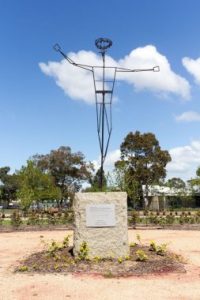 At seven points throughout the labyrinth there are places to pause and reflect. At each point you will find a short piece of scripture, a one line prayer matched to the scripture and a reflective question to ponder as you walk to the next point of reflection. At the centre of the labyrinth you are confronted with a stark sculpture of Jesus. A Jesus stripped bare, with a crown of thorns. At this point you are asked to question how you respond to suffering in the world. Finally, at the end of our prayer journey we are challenged to ‘go forth’, ‘keep Jesus at your centre’ and ‘be his action in the world’. The sculpture at the centre of the labyrinth is the ‘skeleton’ made by our sculptor Chris Sage when forming our ‘Triumphant Jesus’ which hangs above the altar in the chapel.
At seven points throughout the labyrinth there are places to pause and reflect. At each point you will find a short piece of scripture, a one line prayer matched to the scripture and a reflective question to ponder as you walk to the next point of reflection. At the centre of the labyrinth you are confronted with a stark sculpture of Jesus. A Jesus stripped bare, with a crown of thorns. At this point you are asked to question how you respond to suffering in the world. Finally, at the end of our prayer journey we are challenged to ‘go forth’, ‘keep Jesus at your centre’ and ‘be his action in the world’. The sculpture at the centre of the labyrinth is the ‘skeleton’ made by our sculptor Chris Sage when forming our ‘Triumphant Jesus’ which hangs above the altar in the chapel.
 ‘Hullaballoo Studio’ was commissioned to create a statue of Mary MacKillop which captured her spirit and charism. The Artist’s Statement, by Chris Sage, explains her thinking and intent.
‘Hullaballoo Studio’ was commissioned to create a statue of Mary MacKillop which captured her spirit and charism. The Artist’s Statement, by Chris Sage, explains her thinking and intent.
Artist’s Statement
The sculpture of St Mary of the Cross MacKillop and two children, was commissioned by MacKillop College Werribee to coincide with the celebration of 150th year of the Sisters of St Joseph in 2016. This sculpture was placed in the garden next to the new MacKillop College Chapel which was also opened and blessed in 2016. The three figures are moving forward together and Mary’s smile is the connection to the children. We are also able to feel part of the narrative.
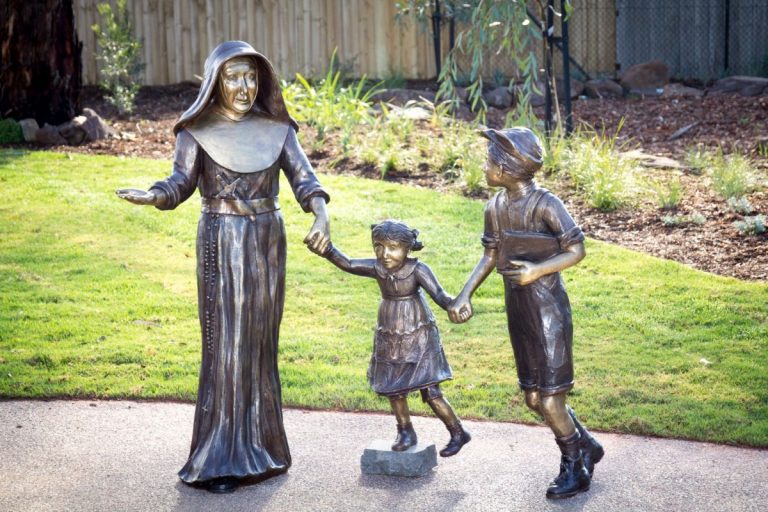
Mary wears the rough-hewn garment of her choice and carries the cross in front of her. Her Rosary beads hang from her waist as a further reminder to us of our connection to Our Lady. Mary MacKillop is shown with her sleeves rolled up, to symbolise the essence of the Josephite practicality and their down to earth approach to life , simplicity and commitment to provide opportunities to those in need.
Not easily seen is the deep pocket which contained sweets for the children and is a beautiful symbol of her desire to bring joy to the young ones. It is also a symbol of our need to be cherished and sustained by love. The young girl is happily contained in a world of her own, trusting and secure in the knowledge that Mary has her hand. The child is experiencing elation, joy, freedom of spirit and trust showing that all things are possible including the leap of faith which life often asks of us.
The little boy is a symbol of all young people looking up at Mary with a sincere endeared look. The young boy is the symbol of trust, hope and expectation. He also holds the little girls hand in a relationship that describes the notion that we do not walk alone, we all need each other and that all things are possible when we work together. He is the other link in the Leap of Faith. He holds the book securely under his arm. The book symbolizes sacred relationship between teacher and student and also The Word.
Mary is smiling and walks easily with the children but casts her glance ahead, availing her message to everyone who comes to the sculpture. The decision to break away from the traditional elevation of the sculpture was to show St Mary of the Cross in her realness, the physical way she walked on this earth among others. Looking up at sculptures gives a sense of greatness but this way people can be with Mary as she was. Understanding that greatness does not come from statue but from within.
The ability for the people to walk around Mary and the two children was a conscious decision so that they didn’t have to reach up to her but be with her as she is with us in our daily living. The ability to interact with her physically is made possible by the outstretched hand which is also an invitation for us to give our intentions to her.
 Just outside the reflection space in the Chapel of St Mary of the Cross sits our water feature entitled ‘The Source’.
Just outside the reflection space in the Chapel of St Mary of the Cross sits our water feature entitled ‘The Source’.
‘The Source’s’ flowing waters are a representation of God’s abundant life in us and reminds us that God is the ‘source’ of all life. Surrounding the water feature are three ornamental olive trees. Combined, the trees represent the Trinity: The Father, the Son and the Holy Spirit. Olive trees were specifically selected for this purpose as they are often represented in the Holy Scriptures and are the source of Chrism (holy oil).
The water feature itself is made up of seven corten steel steps each representing one of the seven sacraments. Into each step the name of the sacrament is cut into the steel and this is highlighted with copper.
The key idea behind this water feature is that the seven sacraments come as gifts from God, represented here as the Trinity.
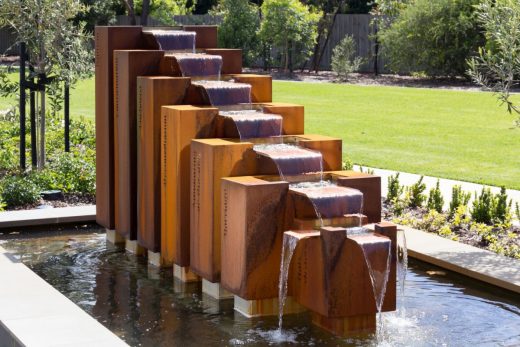
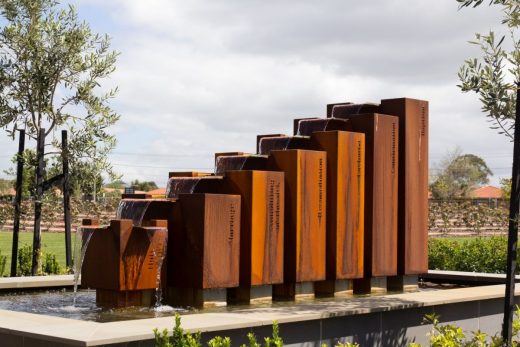
 The Chapel bell was commissioned from the Bagot Bell Company of Adelaide. This company imported the bell from Belgium as there are no manufacturers of bells of this size and calibre produced in Australia.
The Chapel bell was commissioned from the Bagot Bell Company of Adelaide. This company imported the bell from Belgium as there are no manufacturers of bells of this size and calibre produced in Australia.
According to Church Tradition a chapel bell is required to be blessed and baptised in a special ceremony prior to it being hung. This ceremony took place on Tuesday 6 September 2015 and this marked a significant milestone in the development of our Chapel of St. Mary of the Cross. Before the bell was hung it was blessed by all three of our school chaplains: Fr. Frank Buhagiar, Fr. Benneth Osuagwa and Fr. Shymon Thekkekalathungal. In line with church tradition Fr. Frank gave the bell a name – Saint Joseph. He selected this name in honour of the connection St. Joseph has with the Werribee area and in particular his connection to St. Mary of the Cross MacKillop.
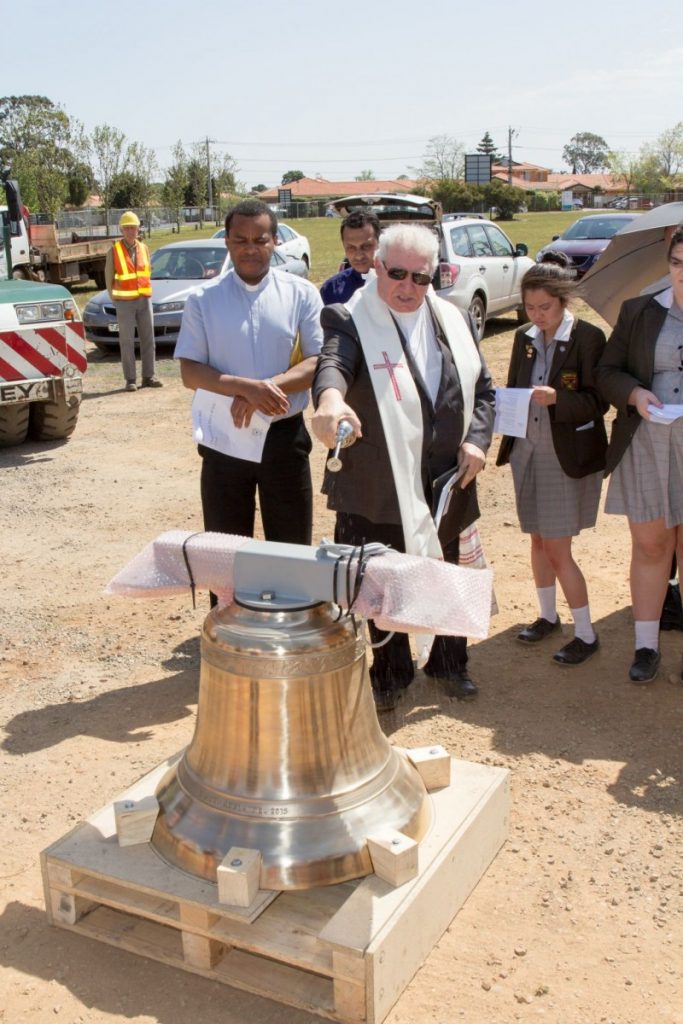
Our bell is an important feature of the Chapel and is will be rung to signify a call to prayer and Eucharist and in time of celebration. In the course of a school day the bell is typically rung three times: once at morning homeroom as a call to prayer, again at midday and finally in afternoon homeroom. This is called our ‘Echo of the Angelis’ and is our reconnectualisation of this ancient and powerful prayer.
The following is a section from an interview with Fr. Frank Buhagiar, Parish Priest of St Andrews about why the name St. Joseph was chosen for the Chapel bell.
Fr. Frank’s Reflection on naming the Bell.
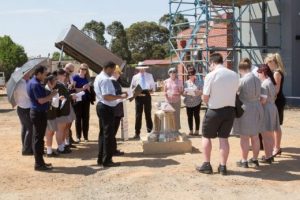
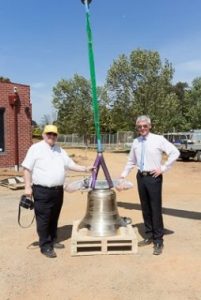 “Why we have chosen the name of St Joseph for our Bell now, that is placed in the tower of the Chapel of St Mary of the Cross; the reason is very powerful. First of all we have the Sisters of St Joseph in this Parish and one of them still active at MacKillop College and they came to our Parish in 1910 and they started naturally, looking after St Andrews School and then later on they started also looking after MacKillop College.
“Why we have chosen the name of St Joseph for our Bell now, that is placed in the tower of the Chapel of St Mary of the Cross; the reason is very powerful. First of all we have the Sisters of St Joseph in this Parish and one of them still active at MacKillop College and they came to our Parish in 1910 and they started naturally, looking after St Andrews School and then later on they started also looking after MacKillop College.
But, in 1953 they also started the school, parish school at Werribee South and that is where they started the feast of St Joseph. The Italian community started that beautiful feast called the SAGRA of St Joseph and that feast is still being celebrated now. The school, being taken over by Mary MacKillop, that feast is still being celebrated every year on 19 March, the feast of St Joseph, and naturally the feast of the Sisters of St Joseph. So in my reflection and also looking at all different sayings I came to the conclusion that St joseph should be very prominent in the whole scheme of MacKillop College spiritual journey as a Catholic school and also the Bell is a very special sign of our Catholic Identity and when you hear the voice of the Bell always praise God, thank God for all the Saints, especially St Joseph”. The bell was donated to the College by the Parish of St. Andrews.
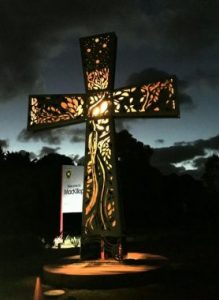 The ‘Cross of Life’ sits in our drive way as a tangible sign of our Catholic Identity. It acts as a beacon to our community and clearly articulates our heritage and beliefs.
The ‘Cross of Life’ sits in our drive way as a tangible sign of our Catholic Identity. It acts as a beacon to our community and clearly articulates our heritage and beliefs.
The ‘Tree of Life’ image is a motif repeated from our Chapel of Saint Mary of the Cross. The ‘Tree of Life’, in Catholic Christianity, represents humanity free from corruption and sin. The tree first appeared as a potent symbol in Genesis as the source of eternal life in the Garden of Eden. Over time many theologians, including Augustine of Hippo and Pope Benedict XVI have compared Christ to the tree of life. The tree is a tangible symbol of death and resurrection that we can relate to.
Our ‘Cross of Life’ features stars and the Southern Cross at its top. This is in reference to Our Lady of the Southern Cross’ – Mary the mother of Jesus and also firmly places this cross within the context of Australia and the broader cosmos.
At the base of the sculpture are symbols used by the first people of the local area (the Kulin people) that represent community and the flowing river of life.
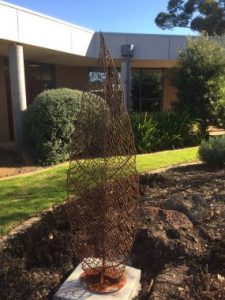 One of the best words we have to describe the season of autumn is bittersweet. It is a time of many moods, some sad and some inspirational. How can we not be moved by the dramatic changes of color, the cooler weather, the descending darkness, and the barren branches contrasted against the stark sky.
One of the best words we have to describe the season of autumn is bittersweet. It is a time of many moods, some sad and some inspirational. How can we not be moved by the dramatic changes of color, the cooler weather, the descending darkness, and the barren branches contrasted against the stark sky.
As we see time and again during the autumn, the trees shed their leaves as part of the cycle of renewal. This is a universal principle – in order to grow, we must release something.
This is true of our own bodies in ways we don’t even notice; we are constantly shedding old cells and creating new ones. If our physical bodies didn’t have this process, we’d have a much shorter life span, as the old tissues would wear out rather quickly.
Autumn’s energy causes us to take stock and decide what to hold on to and what to let go. This process may require you to practice forgiving yourself or someone else.
It may bring you new opportunities that necessitate making changes to accommodate them. It may bring up grief, even if you know that what you’re releasing is a good thing.
Although we must all let go of our past, we also integrate those experiences into ourselves as wisdom. The leaves that fall lose their form, but as they break down into compost, their transformed substance continues to serve the growth and well-being of the tree.
 Thirty-one standard roses have been planted across the front of the Chapel. Each rose is in honour of one of the Sisters of St. Joseph who have selflessly served the MacKillop Community since the college was established in 1970.
Thirty-one standard roses have been planted across the front of the Chapel. Each rose is in honour of one of the Sisters of St. Joseph who have selflessly served the MacKillop Community since the college was established in 1970.
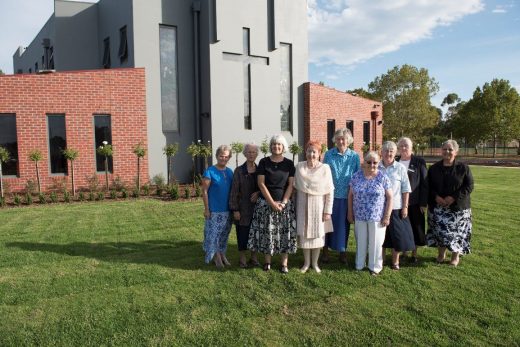
| As Principal of MacKillop | |
| 1970-73 | Sr. Giovanni Farquer |
| 1974-79 | Sr. Helen Reed |
| 1980-81 | Sr. Marie Hanger |
| 1983-95 | Sr. Giovanni Farquer |
Sisters of Saint Joseph of Sacred Heart |
|
| 1970-71 | Sr. Clare Schultz |
| 1970-72 | Sr. Diane Moore (Zita) |
| 1971-72 | Sr. Catherine Pierce |
| 1972-74, 1983-90, 1997-02 | Sr. Mary-Fran Coburn |
| 1973 | Sr. Petrus de Bont |
| 1973-74 | Sr. Therese Wolfe |
| 1974-77, 1981-82 | Sr. Patricia Robertson |
| 1975-81 | Sr. Joan Ryan |
| 1975-77 | Sr. Patricia Leahy |
| 1978 | Sr. Veronica Lonergan |
| 1978-81 | Sr. Martin Bolger |
| 1978-80 | Sr. Joyce Southern |
| 1981-84, 1986-90 | Sr. Philomena McGuigan |
| 1983-93 | Sr. Therese Quinn |
| 1985-88 | Sr. Annette Flockhardt |
| 1986 | Sr. Catherine Mead |
| 1987 | Sr. Annette Coulthardt |
| 1988 | Sr. Rita Malavisi |
| 1988 | Sr. Patricia Stone |
| 1989-96, 1998-10 | Sr. Carmel Crameri |
| 1990-93 | Sr. Lynette Young |
| 1992-93 | Sr. Cathy Dean |
| 1995 | Sr. Margaret Malady |
| 1997 | Sr. Teresa Shaw |
| 1997- | Sr. Geraldine Whelan |
| 1999-01 | Sr. Eileen Carr |
 The altar, font, candle holder and ambo have all been designed to have, as part of their construction the shape of a cross. This may be in the silhouette or the base of each piece of furniture, in some cases it may even be the shadow created by the piece. This is a direct reference to Saint Mary of the Cross MacKillop but also that the cross is the central image to our faith.
The altar, font, candle holder and ambo have all been designed to have, as part of their construction the shape of a cross. This may be in the silhouette or the base of each piece of furniture, in some cases it may even be the shadow created by the piece. This is a direct reference to Saint Mary of the Cross MacKillop but also that the cross is the central image to our faith.
Each piece of sacramental furniture has subtle inlays of a contrasting timber inserted into the frame. This wood comes from a floor board from the Cameron Homestead, built in 1848 on the original section of the Penola station and where Mary MacKillop worked as governess in 1861.
The Font
The glass of the font was constructed for us by Wathaurong Glass and Arts, owned by the local Wathaurong Aboriginal Co-operative. The name “WATHAURONG” (wathawurrung or wada warrung) is a recognised tribe, it consisted of 25 groups (clans). The boundaries of Wathaurong are from Geelong (Victoria), North to Werribee River, North West to Bacchus Marsh, South West to Cressy, South East to Colac, East to Lorne & North back to Geelong encompassing the Bellarine Peninsula.
The bowl of the font was designed to contain a number of symbols, significant to the Wathaurong people but that are also significant in our own tradition.
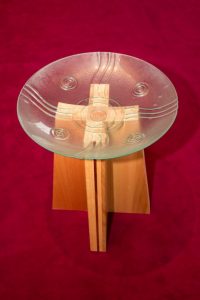
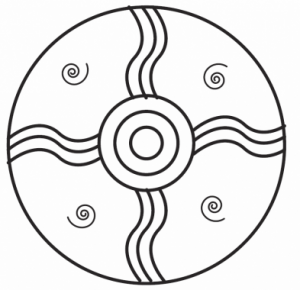
Central circles represent community around a waterhole
The wavy lines represent a river and/or journey
The spirals represent wind or the spirit.
Each of these is a significant symbol in the sacrament of Baptism and Confirmation.
The font is placed at the back of the Chapel. As we enter the Chapel we will use the water of the Baptismal font to bless ourselves and remind us of our own baptisms.
The font was donated to the College by the 2016 Parents and Friends Committee.
The College commissioned Staff Member and Artist, Mr Silvio Mannello to paint two contemporary pieces of Religious Art.
Painting #1: Jesus
The College wanted an image of Jesus that was inviting and hospitable, and one which students could easily connect with when they looked upon it.
Painting #2: Joseph the Carpenter and the boy Jesus
St Mary of the Cross MacKillop had a great devotion to St Joseph, the husband of Mary. She admired his faithfulness, humility and steadiness. The College wanted a representation of Joseph that honored his place in the life of Mary MacKillop, and highlighted his role as teacher and parent to Jesus
The Artist’s Statements: Mr Silvio Mannello
‘Jesus at the Sea of Galilee’
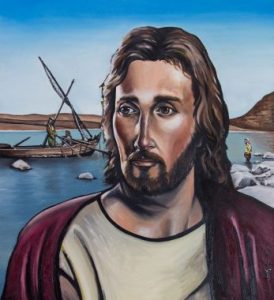 I was approached by the college with the commission of coming up with a design for an image that would portray a likeness of Christ unique to our school and its community. The explicit brief was that the face of Jesus was to be warm, inviting and something that didn’t fit the normal formula of Jesus portraits of the past. In my painting I place Christ in an important setting which is on the banks of the Sea of Galilee. A place where he lived and worked and is such a crucial part of his ministry. His human quality is front and centre for all to see and his eyes are an entry point for the viewer to engage in his humility and calmness. The positive feedback I have received from this painting has been overwhelming and I hope the MacKillop community continue to enjoy it for years to come.
I was approached by the college with the commission of coming up with a design for an image that would portray a likeness of Christ unique to our school and its community. The explicit brief was that the face of Jesus was to be warm, inviting and something that didn’t fit the normal formula of Jesus portraits of the past. In my painting I place Christ in an important setting which is on the banks of the Sea of Galilee. A place where he lived and worked and is such a crucial part of his ministry. His human quality is front and centre for all to see and his eyes are an entry point for the viewer to engage in his humility and calmness. The positive feedback I have received from this painting has been overwhelming and I hope the MacKillop community continue to enjoy it for years to come.
‘St Joseph Teaching Jesus’
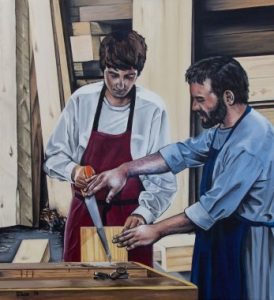 Many images have been created over the years that have portrayed St Joseph with his son, Jesus. I tried so hard to make sure that MacKillop received something unique and special to grace its walls. Technique wise, it was one of the more challenging pieces I have created. This is due to the complexity of the image and the nature of the medium that I worked in, which was oil paint. My brief was to show a young Jesus being taught carpentry by his father. The basis of the design comes from a promotional image that was taken of myself in my first year of teaching. This photo had me gesturing to a young year 10 student in a wood work class. The young Christ’s eyes are fixated on Joseph’s hands as they guide and instruct him. St Joseph is such a crucial figure in Jesus’ early years and an important mentor whose massive impact cannot be underestimated. This is why he was such a central figure to the life of Mary MacKillop and all of the Sisters of St Joseph. The visual message in this piece highlights the significant roles of both the teacher and the student within our college. May St Joseph guide us all.
Many images have been created over the years that have portrayed St Joseph with his son, Jesus. I tried so hard to make sure that MacKillop received something unique and special to grace its walls. Technique wise, it was one of the more challenging pieces I have created. This is due to the complexity of the image and the nature of the medium that I worked in, which was oil paint. My brief was to show a young Jesus being taught carpentry by his father. The basis of the design comes from a promotional image that was taken of myself in my first year of teaching. This photo had me gesturing to a young year 10 student in a wood work class. The young Christ’s eyes are fixated on Joseph’s hands as they guide and instruct him. St Joseph is such a crucial figure in Jesus’ early years and an important mentor whose massive impact cannot be underestimated. This is why he was such a central figure to the life of Mary MacKillop and all of the Sisters of St Joseph. The visual message in this piece highlights the significant roles of both the teacher and the student within our college. May St Joseph guide us all.


